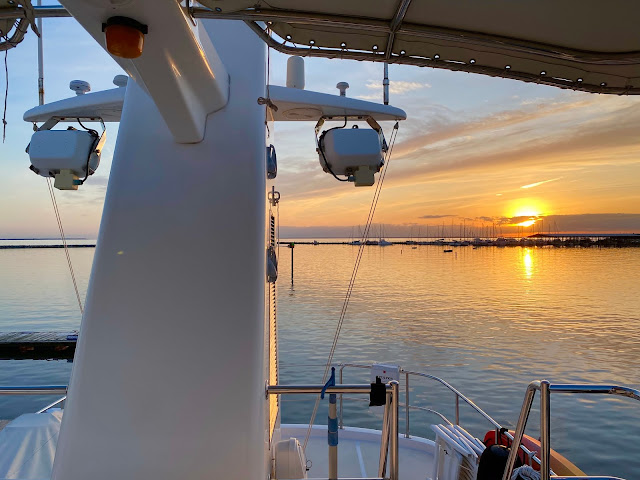The Chesapeake Bay impact crater
We left our boat in storage on Chesapeake Bay in early June. We brought it that far north and into a reinforced building to protect it from severe storms and hurricanes.
This summer, we learned we'd actually left in an area that had experienced the 10th largest asteroid impact on earth.
In fact, most of Chesapeake Bay was formed by that asteroid impact. Here is a some fascinating information about this event.
This collision happened 35 million years ago. The Chesapeake Bay Impact Crater is one of the best-preserved "wet targets." A wet target is an impact that happens in or above water.
The time of the impact was the late Eocene epoch. Temperatures were high, with very high sea levels as well. The western shore of the Chesapeake was covered in thick rain forests.
The asteroid was nickel and iron rich. It was 3 miles (3-5 km) wide. When it made "contact," it was traveling somewhere between 21 (34 km) and 37 miles (60 km) per second. That's between 77,000 and 33,200 miles per hour!
It made a deep hole through layers of sediment and into the granite below. This asteroid was actually a "bolide" which is an asteroid that explodes in the atmosphere (an airburst).
[Why did this one airburst? When an asteroid comes hurtling towards earth this quickly, the atmosphere in front of it becomes so highly pressurized, it seeps into the asteroid itself through its pores and cracks, violently pushing it apart. Here is a link to videos of the Chelyabinsk, Russia airburst of 2013. https://youtu.be/DR49rHKycpE FYI, the Chesapeake Bay asteroid was traveling 2 to 4 times as quickly as the Chelyabinsk one.]
So it wasn't an actual impact that caused the Chesapeake Bay Impact Crater, it was the explosion. However, the explosion was incredibly powerful...
- It created a crater after just 2 seconds of impact that was 17 miles wide.
- It fractured the rock and ground 5 miles (8 km) into the earth.
- It ejected a plume of melted and ejected bedrock, smoke, and steam 15 to 30 miles high.
- It created a wave perhaps as tall as 1,500 feet (roughly the side of the largest wave of our times -- the 1958 Lituya Bay wave in Alaska).
- It ultimately made a crater that was 53 miles (85 km) in diameter -- the approximate size of Rhode Island.
- It made a hole in the ground 0.81 miles (1.3 km) deep -- nearly as deep as the Grand Canyon.
The area around the explosion suffered mass destruction. Within minutes, millions of tons of water, sediment, and shattered rock were cast high into the atmosphere and hundreds of miles along the east coast. The enormous mega-tsunami that followed may have even made it to the Blue Ridge Mountains.
This entire process lasted from a few hours to a few days.
__________
So, how safe was it for us to leave our boat in this area?
Meaning, could this happen here again?
Yes, of course it could. But the chances of a major asteroid impact on earth are between 1:150,000 and 1:110,000 over the course of the next hundred or so years.
The chances of it happening in this very area again? Interestingly the same odds as above, because such events are entirely random.
Even my dad isn't worried. :)
These are the different types of space objects.
Finally here is the beautiful end product of such a destructive force.
The Chesapeake Bay.
Check out this amazing website
Nasa solar system exploration












Thanks for sharing - fascinating article.
ReplyDeleteAsteroids are fascinating
ReplyDeleteBut in this post the front picture is my favorite.
Salter, I bet this is your favorite post. I know how much you love reasearching anything about space. I didn't know there was a difference between meteoroids and meteorites. Good thing there's been no airburst while you and Dad are still on the Chesapeake. Keep up the great posts. Love, Mom
ReplyDeleteActually the airburst or bolide is worse in this case
ReplyDeleteyes this is absolutely my favorite post yet 😁
Fascinating! I have visited Annapolis and The Chesapeake Bay but had no idea how it was formed. Thank you for sharing Salter. I am very interested in reading about your adventures.
ReplyDeleteThanks Salter - love reading your blog - I always learn something new!
ReplyDelete